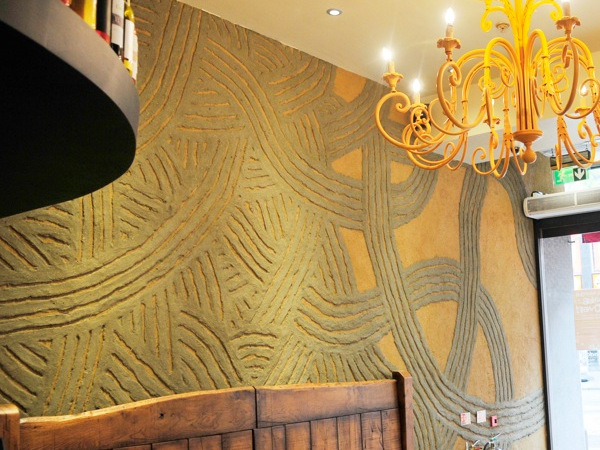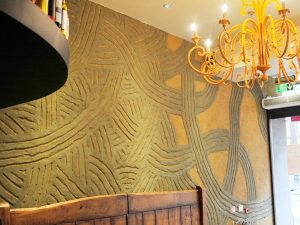“The skills needed to create and apply natural finishes are easy to learn and the tools required are minimal, most people quickly picking up the skills as though something inside them has been rekindled from former lives!” – James Henderson
Contents
What are clay plasters?
Clay or earth plasters are blends of unfired clays mixed with fine sand to provide a natural, breathable finish for internal walls. They have been used all over the world for thousands of years, and still exist in lots of traditional vernacular buildings. Clay plasters were often used in old buildings in the UK as a base coat, with a top coat of lime, as clay is cheaper than lime.

Clay is a better description than earth, as earth contains aggregates (stone, gravel) and also living material. Clay is formed from the chemical weathering of feldspar rock, and is found in every country. It’s a clayey subsoil that’s used, not topsoil.
Clay plaster can be used as a base coat when mixed with coarse sand, with hemp or straw binder chopped into it, and can be used with finer sands to produce a top coat. There are many different kinds of clays that can be used in plasters. Some clays are hard but not very hygroscopic (see ‘benefits’), and some are softer but absorb more moisture. The best plasters will be hard and hygroscopic, and often the best way of achieving that is by blending clays.

Clay plasters fell out of favour in the 20th century with the move towards synthetic, non-breathable building materials, but we’re seeing a revival now, with more interest in natural homes for environmental and health reasons. Clay plasters are for internal use only, but can be used externally as a base coat for a lime top coat.
What are the benefits of clay plasters?
Environmental benefits
- If you make your own base plaster, material can be sourced locally, with lower or no transport costs / emissions.

- Unlike gypsum (and lime, although lime re-absorbs CO2 on setting), no firing required, so lower energy use / emissions.
- Totally non-toxic and biodegradable.
- Clay doesn’t set chemically like gypsum does – it just dries; so at least for the base coat, if it dries, you can wet it and knock it back up again, which means less waste.
Benefits for buildings
- Breathability: clay plasters prevent excess moisture in vulnerable buildings. Clays are hygroscopic – they absorb moisture if humidity is high, hold it without being damaged, and when humidity falls, release moisture back to the air. So they maintain a consistent humidity and minimise damp, and moulds caused by condensation.
- Gypsum, on the other hand, absorbs moisture, but it’s not breathable, and it doesn’t let moisture out again, so it gets damaged in the process – via moulds, and / or the plaster ‘blowing’ (losing adhesion), and falling off.
- Clays can be used with / over other breathable materials without taking away their breathability.

- Flexibility: clay is soft and pliable, and can move, like lime, without cracking; it can cope with situations where you get minor movements, and so is excellent in old houses. Gypsum isn’t flexible, and cracks with any minor movements.
- Protection of timbers: lime absorbs moisture through capillary action, but with clay, there’s a chemical attraction that draws moisture in – and because clay absorbs moisture at a faster rate than lime or timber, it takes moisture away from the timbers of the building, protecting them from damp, mould, rot and insects.
- As clay absorbs moisture, it seals and prevents water from passing right through into the structure of the building. Moisture is held and released when the air around it dries. This is why clay can be used to line a pond – clay allows so much moisture in and then provides a barrier.
- Aesthetic: clay plasters are beautiful in their texture / the way they reflect light, and they have an organic, natural feel.

Health benefits
- Clay plasters maintain a consistent relative humidity of around 50-60%, which is beneficial for people with asthma or other respiratory problems, but detrimental to dust mites – which reduces problems associated with allergies.
- Clays contain no nasty chemicals, and are able to absorb toxins and thus improve indoor air quality. Even if you avoid toxic cleaning / househould products, in this day and age, it’s difficult to avoid toxins completely, and so clay plasters can help.
- You have to be in a room with a clay plaster to understand how beautiful, sensuous, natural, earthy (add your own epithet here) they are. They just make you feel good.

Other benefits
- Clay plaster is a product that can be produced locally, without benefitting the extractive corporate sector.
What can I do?
Learn as much as you can first. See our further info section for more details on application and maintenance of clay plasters.
You can buy base coat and top coat plasters, or you can have a go at making a base coat (bought plaster will be much finer, so it may be better to buy the top coat). First test whether you have clay. The field test is that clay is sticky and can be rolled into a sausage shape. See Using Natural Finishes and other books for more detailed tests, plus lots more information on making and applying clay plasters.

The clayey earth is dug out of the ground and then soaked and sieved to remove aggregates. What’s left is clay. Let that stand and keep taking water off the top until it dries. Clays are not uniform, so they will differ in composition depending on locality. This may take a little experience.
Mix the clay with coarse sharp sand for a base coat – roughly 3 parts sand: 1 clay (and chop in straw or hemp for binder, which helps with shrinkage and stops it cracking when it dries). Then add water until you have the right consistency for a plaster. For a top coat, use the same ratio of sand and clay, but use a finer grade sand, like silver sand.

Apply 10-15mm of base coat, and 3mm of top coat. Apply the top coat in thin layers, and don’t over-trowel, as it brings the moisture to the surface, with makes it liable to crack as it dries. Lay the base coat on with a steel float, then scour with a wooden / plastic float, which compresses the surface and gives a good hard surface for the top coat. Apply the top coat with a metal float, then burnish with a plastic trowel – steel might mark the pigment, but plastic doesn’t (and it doesn’t bring water to the surface as much either). If you’re plastering over 2 different surfaces, e.g. brick and cob, to prevent cracking, it may be a good idea to use hessian or glass fibre mesh. Apply the base coat, then push the mesh in, and trowel over it.
Clay plasters can be painted with breathable paints, but nowadays you can also buy more refined top coats that will provide a finer finish and can be bought already containing coloured natural pigments, saving time and money.

Clay plasters have good impact resistance – but not to constant banging / rubbing, so they may not be ideal for areas of high traffic, or for hospitals or schools. But they can be used if there’s a handrail to stop too much contact. They’re certainly be a good idea in public buildings, because of their health benefits.
Specialist(s)
Thanks to Paul Fitzpatrick of Strawhaus for information and Clayworks for photographs.
The specialist(s) below will respond to queries on this topic. Please comment in the box at the bottom of the page.

Phil Christopher is an environmentalist, builder and trainer and he believes in making a low-impact lifestyle an attractive possibility for everyone. Phil runs Huff and Puff Construction, specialising in straw bale and sustainable building, training and design. He’s a passionate advocate of earthen and lime plasters, stating “It’s the part everyone loves doing, even if they didn’t think they would!”



9 Comments
I would love to know if anyone has used the clay from their own soil to render their house. We are self building using natural materials and have very heavy clay soil…
Hi Stephanie,
We do this, it’s a great idea. If foundations are dug it can help use that material up, and you can’t get materials much closer to your build, of course.
However, economically, it takes time to process the clay, and this needs to be balanced with the alternative cost of buying materials in.
If you have pure clay, with few to no stones, it will be the least work. You can process wet or dry. I prefer wet – get the clay soaked in a bucket or plasterer’s bath and then mix using a paddle mixer. You could even do small samples by hand.
You can then do test mixes with different proportions of sand and fibre (hemp shiv is good) and apply these to a substrate, so you can see how your clay will work best.
All the best,
Phil
Can we mix lime into a clay plaster for exterior walls? Or do we have to choose between all-lime or all-clay?
Hi Hannah,
It will depend to a degree on the substrate, e.g. cob or straw. Generally in the UK folk will use lime render externally for the best weather protection. One concern is that earth rich external renders may hold more atmospheric moisture for longer and therefore substrates such as straw may be adversely affected.
Lime stabilised clay is used more widely elsewhere though. I would suggest contacting Earth Building UK and Ireland (EBUKI) for advice – http://ebuki.co – and also Bee Rowan from Strawbuild – [email protected] – who has done a lot of research into lime stabilised earth.
Also see this American page for some practical information: https://thesustainablehome.net/lime-stabilized-earth-base-coat/. Note this is being used as a base coat only, still relying on a more weather protective coat of lime to finish.
All the best,
Phil
[email protected]
It’s a great source of knowledge; I think it will be helpful for lot of people who are looking for clay earth plasters . Thank you very much for sharing this article, this is really helpful for me, thanks again and looking for more in future!
HI
I’m from England and was wondering what the cost is for sqm of clay plastering
Hi Hughie,
There are lots of variables, I’d suggest the financial cost would be comparable to lime plastering.
Taken holistically, the fact that the materials are easily found and it’s a straightforward thing for folk to learn themselves, the only financial cost could be one’s labour.
Can i get some consultancy for the product development.
we can talk
mahendra
+919079656429
It caught my interest when you informed us that clay plasters have no nasty chemicals since they don’t set chemically like gypsum while also offering us lower energy use and emissions. I’m adding a patio area facing my backyard garden at home in Echuca, and I have decided to use plaster for the decorative wall. I’ll take note of this information while I look for a contractor inn Echuca to contact about plaster supplies soon. https://www.gvplaster.com.au/plasterboard-products